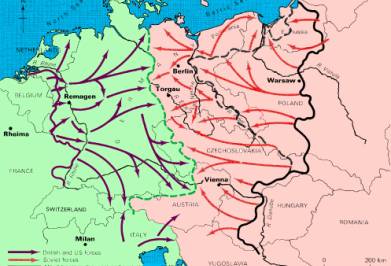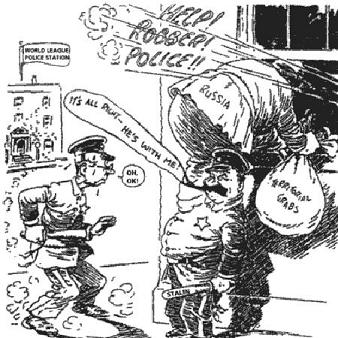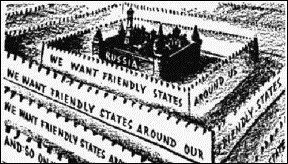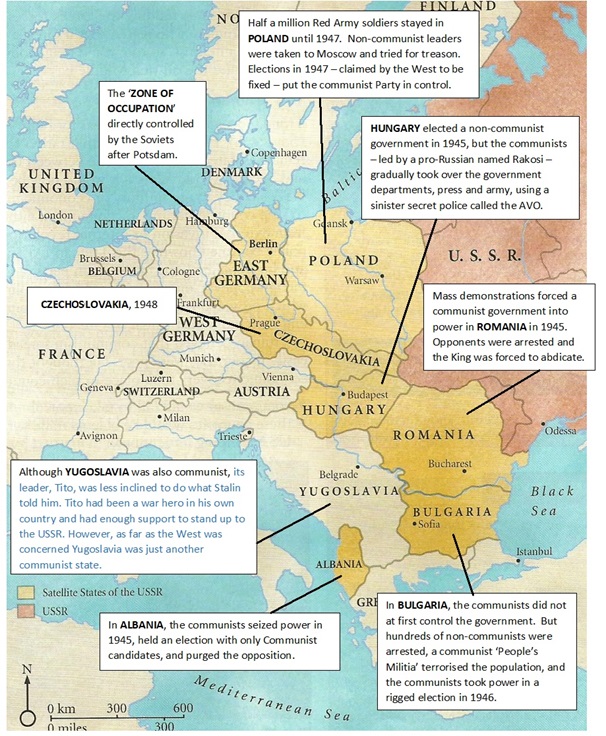|
|
|
| Like a plague overlooked by incompetent doctors, the new political order, called communism, spread... With the power of guns, few communists and mutual agreement of the Allies, Communist Russia became the new ruler over the country. What followed was the systematic destruction of democracy, by terror, murder, corruption, lies and propaganda. People died, were arrested, deported. The luckiest ones fled the country. The rest of them entered a dark era. Amateur writer Camelia Krausmann, The Communist Takeover of Central and Eastern Europe after 1945 on Helium.com. Camelia, who lists her first job as ‘carpenter’, is a contributor on many subjects from surviving breast cancer to how to make Turkish coffee. |
|
|
|
Going DeeperThe following links will help you widen your knowledge: Did 'Salami tactics' actually happen?
What was different about Yugoslavia?
◄ 1945: the arrows show the British and Americans from the west, the Russians from the east, advancing into Germany. Most of eastern Europe (except for Yugoslavia) fell under the control of Russia (although Finland was slightly different).
|
|
As the Red Army beat back the Nazis in 1944-45, Stalin had already devoured the Baltic states of Estonia, Latvia and Lithunia, along with a huge chunk of Poland. Then, during 1946–47, he made sure that Communist governments came to power in what came to be called the 'Iron Curtain' countries. These were all the countries of eastern Europe which Russia had occupied in 1945. "What is surprising about the fact that the Soviet Union, worried about its future safety, wants governments friendly to it in Finland, Poland and Romania?" he wrote in 1946.
Did You Know?Churchill was worried about Soviet influence in eastern Europe even during the war, and clashed with Stalin over it at the Tehran Conference of 1943. In October 1944, Churchill went to Moscow to meet Stalin face-to-face and made the so-called ‘percentages agreement’, where Churchill suggested that Russia and Britain agree ‘spheres of influence’ in the different countries of eastern Europe (Romania 90-10, Greece 10-90, Yugoslavia and Hungary 50-50 etc.). Stalin agreed. Although the Soviet Union took complete 100% control of the Iron Curtain countries after the war, Stalin did keep his promise to stay out of Greece.
How did Stalin take control of the countriesof Eastern Europe?The Hungarian Communist Rakosi described the process as ‘slicing salami’ – gradually taking control of the different organs of government, and getting rid of all opposition, bit-by-bit. In this way, Russia gained control of:
Albania (1945) – the Communists took power after the war without opposition
Bulgaria (1945) – a left-wing coalition gained power in 1945; the Communists then executed the leaders of all the other parties.
Poland (1947) – a coalition government took power in 1945, but Stalin arrested all the non-Communist leaders in 1945, and the Communists forced the other non-Communists into exile.
Romania (1945–1947) – a left-wing coalition was elected in 1945; the Communists gradually took over control.
Hungary (1947) – Hungary was invaded by the Russians, and in 1945 the allies agreed that Russian troops should stay there. Stalin allowed elections, in which the non-communist 'Smallholders Party' won a majority. However, some communists were elected, led by a Communist politician and ardent Stalinist called Matyas Rakosi. Rakosi now started demanding that groups which opposed him should be banned. If not, he hinted, the Russians would take over the country. Then he got control of the police, and started to arrest his opponents. He set up the AVO, a sinister and brutal secret police unit. The AVO arrested hundreds of Smallholder Party members, so that it lost its majority in Parliament. The Party's General Secretary Béla Kovács was deported in the USSR in 1947. Prime Minister Ferenc Nagy resigned when his son was threatened. By 1947 Rakosi had complete control over Hungary.
Czechoslovakia (1945–48) – a moderate left-wing coalition – the 'National Front' – was established in the town of Kosice 1945. In the 1946 elections, the Communists gained only 38% of the seats, but they gradually bullied and threatened their way into power. In 1948, they banned all other parties and killed their leaders.
East Germany (1949) – the Russian turned their zone of Germany into the German Democratic Republic in 1949.
|
Source AIn this American cartoon from 1946, the thief labelled ‘Russia’ is caught stealing a bag labelled ‘territorial grabs’. He is being helped by Stalin, who is dressed like a policeman and holding a truncheon. Policeman Truman, from the 'World League Police Station' is too late to stop him. Click here for the interpretation
Source B... Russia saw it as protecting herself from future attack. The West saw it as empire-building.
Source CINTERVIEWER: What sort of tactics did the Soviets use to try and bring about an amalgamation [in East Berlin]? LORD ANNAN: Well, the usual ones which the Communists practised all over Europe - I mean, falsifying elections, bringing pressure to bear on people, extra rations for those who went the right way. Those were the sort of mildest things. But anybody who really stood out against it and made impassioned speeches, they were kidnapped and never seen again. Now, from the British point of view ... if that had happened nationwide and there was a nationwide Communist Party, because that's what it would have been, that would have been very much against our interests. Lord Annan, who at the time was a senior officer in the British Control Commission in Germany, interviewed in 1996
Consider:1. Make a spidergram showing all the factors that helped Communists take power. 2. Explain how the case of Hungary illustrates ‘salami tactics’. 3. Use Sources A-D to explain how the West saw the Russian takeover of eastern Europe.
|
Source DThis cartoon by the British cartoonist Illingworth was published in June 1947 Click here for the interpretation
Source ESalami tactics - Stalin takes control of Eastern Europe.
|
|
|
|
|
|
Spotted an error on this page? Broken link? Anything missing? Let me know. |
|



